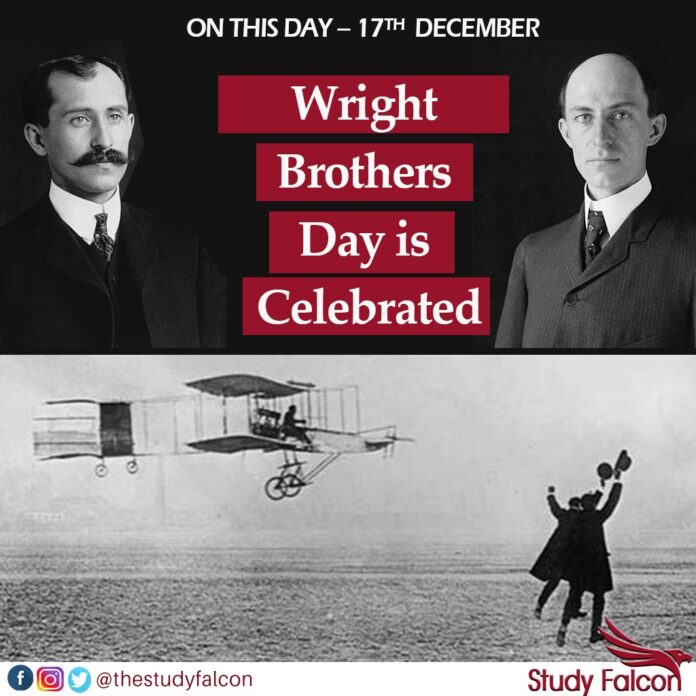Wright Brothers Day is celebrated in the United States on December 17 each year. The date commemorates the Orville and Wilbur Wright’s first successful flight in heavier-than-air, mechanically propelled craft. Wright Brothers Day falls on the same day as Pan American Aviation Day.
From a young age, Orville Wright and his brother, Wilbur, developed a fascination with flight. Father Milton Wright’s preaching took him on the road frequently, and he often brought back small toys for his children Orville and Wilbur Wright. In 1878, he brought back a small model helicopter for his boys. Made of cork, bamboo and paper, and powered by a rubber band to twirl its blades, the model was based on a design by the French aeronautical pioneer Alphonse Pénaud. Fascinated by the toy and its mechanics, Wilbur and Orville would develop a lifelong love of aeronautics and flying.
They first found success manufacturing bicycles, including the Van Cleve and St. Clair. They never lost interest in flight and continued to develop designs. After many years of interest, in the late 19th century they came up with the idea of three-axis control which made it possible for the pilot to maintain the aircraft’s equilibrium and to steer it effectively. Orville and Wilbur Wright used this principle to design and build a series of manned gliders. Their experience testing gliders helped them create the Flyer (which is now referred to as the Wright Flyer, Flyer I or 1903 Flyer). The Wright Flyer was the product of a sophisticated four-year program of research and development conducted by Wilbur and Orville Wright beginning in 1899. It was made from spruce, a strong and lightweight wood. Always working on different mechanical projects and keeping up with scientific research, the Wright brothers closely followed the research of German aviator Otto Lilienthal. When Lilienthal died in a glider crash, the brothers decided to start their own experiments with flight. Determined to develop their own successful design, Wilbur and Orville headed to Kitty Hawk, North Carolina, known for its strong winds.
The brothers made their first attempt at powered flight on December 14, 1903, but it was unsuccessful. Repairs took three days. After building and testing three full-sized gliders, the Wrights’ first powered airplane flew at Kitty Hawk, North Carolina, on December 17, 1903, making a 12-second flight, traveling 36 m (120 ft), with Orville piloting. The best flight of the day, with Wilbur at the controls, covered 255.6 m (852 ft) in 59 seconds.
The Wright brothers soon found that their success was not appreciated by all. Many in the press, as well as fellow flight experts, were reluctant to believe the brothers’ claims at all. As a result, Wilbur set out for Europe in 1908, where he hoped he would have more success convincing the public and selling airplanes.
In France, Wilbur found a much more receptive audience. He made many public flights, and gave rides to officials, journalists and statesmen. In 1909, Orville joined his brother in Europe, as did their younger sister Katharine. The Wrights became huge celebrities there, hosted by royals and heads of state, and constantly featured in the press. The Wrights began to sell their airplanes in Europe, before returning to the United States in 1909. The brothers became wealthy businessmen, filling contracts for airplanes in Europe and the United States.
The Wright Flyer is now on display in the National Air and Space Museum of the Smithsonian Institution, Washington, D.C. The 1903 Wright airplane was an extremely strong yet flexible braced biplane structure.
The United States President annually makes a proclamation inviting Americans to observe Wright Brothers Day with appropriate ceremonies and activities. Observations, including the annual Wright Brothers dinner where the Wright Brothers Memorial Trophy is awarded in Washington DC, take place on or around this day. Celebrations are also held at Kitty Hawk in North Carolina and in Dayton, Ohio, where the brothers were born.
The Wrights pioneered many of the basic tenets and techniques of modern aeronautical engineering, such as the use of a wind tunnel and flight testing as design tools. Their seminal accomplishment encompassed not only the breakthrough first flight of an airplane, but also the equally important achievement of establishing the foundation of aeronautical engineering. Therefore, it is no surprise that 17 December is celebrated as a national observance in U.S. for the achievement of the brothers.










